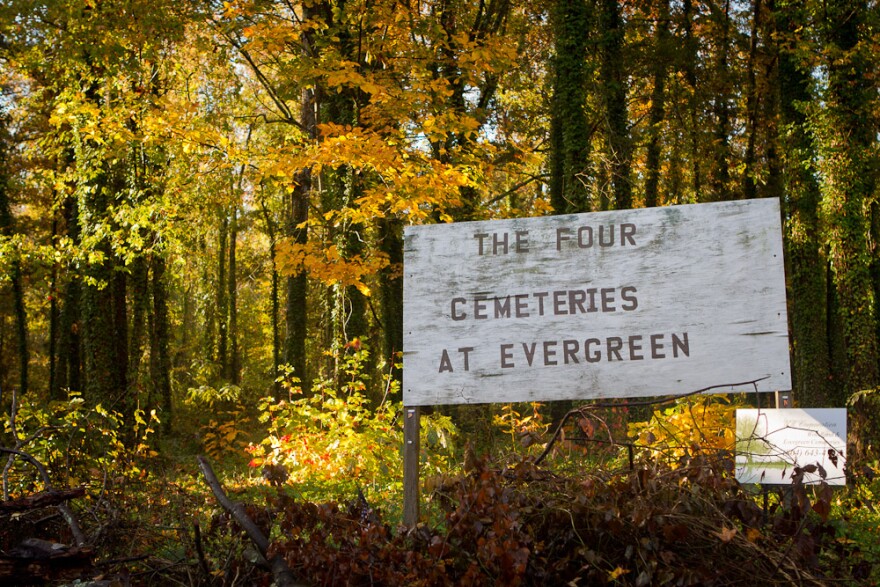Although segregation ended formally in the United States more than fifty years ago, there are places right here in Virginia that are still segregated, and aren’t likely to change anytime soon. Those places are cemeteries. After integration, historically black cemeteries around Virginia fell to the wayside, often unkempt, uncared for, and forgotten.
Buffie Coleman never met her grandmother, she died, before Coleman was born. But as Coleman grew older -- she wanted to learn more.
“I started hearing things about a cemetery where she was buried and no one could find her,” says Coleman.
An online search led Coleman to Evergreen Cemetery, a historically black cemetery in Richmond’s East End.
“I just had this urge. Something was telling me to go over there,” Coleman says. “And the first time I came I actually went to the wrong cemetery.”
Coleman had accidentally pulled into Oakwood, a large well-manicured, historically-white cemetery.
“I found a groundskeeper there, I told him what I was looking for, Evergreen Cemetery,” says Coleman. “His exact words was ‘I don’t think you want to go over there. Ain’t nothing but fleas and ticks and chiggers. You’ll never find anything over there,’.”
It’s easy to think that’s all there is to Evergreen Cemetery, because the surrounding forest has swallowed so much of it. But, it’s actually 60-acres of African-American graves dating back to the 1800’s.
John Shuck is the volunteer coordinator for the cleanup of East End Cemeter , right next to Evergreen. There are four historically-black cemeteries in this complex.
“East End, Evergreen, are the two biggest ones,” Shuck explains. “There’s a small cemetery right here called colored paupers. I’ve been told 800 children buried there.”

The fourth, some guess, is a cemetery for African-American confederate soldiers. Shuck pulls out a map of the complex, lays it on the hood of his truck.
“Where Buffie’s grandmother’s grave is, is somewhere down in this area, right up here,” Shuck says, pointing to a spot far back that’s technically in East End Cemetery.
Shuck has been working in this particular cemetery for the past two years. Since he’s started, he’s has uncovered and documented more than 1,500 graves.
“I treat this as an archeological dig. And we don’t want to lose track of here’s a burial here, until we’ve got it all recorded properly. Which may take several years.”
When Shuck finds a new grave, he puts it online at findagrave.com. That is where Buffie Coleman found a photo of her grandmother’s grave.
While Shuck works slowly, uncovering this one cemetery, there are countless others throughout Virginia that have yet to be discovered.
Lynn Rainvillehas been leading that search in central Virginia.
“Looking for a cemetery you’re looking for locations usually in higher elevations, a hilltop, some sort of rise in the landscape,” says Rainville.
Rainville is a professor and anthropologist at Sweet Briar College. She’s spent the last 15 yearsfinding and documenting more than 150 African-American cemeteries just in Albermarle and Amherst counties.
“It is a lovely time to visit a cemetery!” says Rainville, gesturing to the fall foliage around her. “Of course I think that every time is a time to visit a cemetery. But if I had to pick a perfect season this would be it.”
Rainville loves this time of year because the fallen leaves settle in depressions, allowing her to more easily find graves without markers. That’s largely helped her find old family, or slave cemeteries, that have been all-but-forgotten. Rainville estimates there are thousands that still lay undiscovered.
But, thanks to people like Rainville and John Shuck, that’s not the case for Buffie Coleman’s grandmother. One month after she first found her grandmother’s grave, Coleman heads back out to the site.
Hidden deep among a maze of depressions and ivy is a flat white stone: “Our daughter- Emmaline Turner. June 19, 1935 - June 1st 1956.”
“Once I got here the tears just started flowing and I felt like it was a light. It was like a really good feeling a rush through me, that somebody was smiling down on me,” Coleman recalls finding the grave for the first time.
“And I believe it was her because, I’m her granddaughter. And then not being able to be found, she hasn’t been able to be visited. My mom has never been here since the funeral in 1956 so she’s never even had a resting place to come and sit with her mom and tell her mom that she misses her, that she loves her.”
Coleman would like to bring her mother out to the grave now that she’s found it, but there’s still no clear path, and her mom is in a wheelchair.





